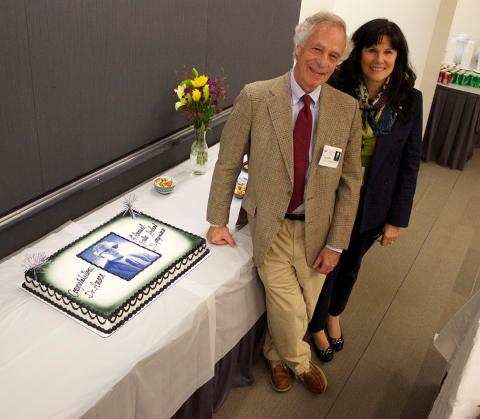Axelrod Symposium Showcases Neuropharmacology Research

This year’s Julius Axelrod Symposium was held to honor the recipient of the 2014 Society for Neuroscience (SfN) Julius Axelrod Prize—Dr. Susan Amara, scientific director at NIMH.
The event opened with a “Remembrance of Julie” given by former NIMH intramural researcher and Axelrod mentee Dr. Michael Brownstein, who reminisced about his years with Julie, as his colleagues affectionately called him.
Often called the father of neuropharmacology, long-time NIH researcher Dr. Julius Axelrod nearly missed out on a career in science. After being rejected by medical schools, he accepted a job as a lab technician. It was as a “technician” that he conducted his early work on caffeine, which led to his later research on the sympathetic nervous system and its major neurotransmitters epinephrine (adrenaline) and norepinephrine (noradrenaline), and eventually the 1970 Nobel Prize.
In her keynote address, Amara said that Axelrod’s scientific contributions while at the NIMH Intramural Research Program inspired her to join NIMH. She explained that her lab was the first to clone the human norepinephrine and dopamine transporters, which—along with the serotonin transporter—appear to be key targets for treatments of neuropsychiatric disorders and addiction.
She credits her success in part to Axelrod’s support: “Dr. Axelrod wrote us a letter, gave us some advice and sent us some papers.”
Amara’s early work advanced understanding of how proteins shuttle signaling neurotransmitters back and forth across neurons’ cellular membranes. More recently, her studies of psychostimulants and antidepressants have helped to elucidate how these agents affect neurotransmitter-transporter signaling properties, physiology and regulation.
In addition, Amara has trained more than 30 graduate students and postdoctoral fellows and held numerous leadership positions in professional societies.
“I always liked it that Julius Axelrod followed an unconventional path,” she noted. “He got his Ph.D. in his 40s after working in a lab for years. It is a lesson that there are many different paths to a career in science. And it is an encouraging story for students—and for the rest of us.”
NIMH visiting fellow Dr. Qin-Hua Gu, who won the 2015 NIMH IRP Fellows’ Axelrod Award, spoke on specific miRNAs she has helped to identify as essential for maintaining neuronal plasticity in learning.
The 9th annual Julius Axelrod Symposium will be held at NIH in the spring of 2017 to honor the 2015 Julius Axelrod Prize awardee Pietro De Camilli, chair of the department of cell biology at Yale University School of Medicine, and the 2016 recipient, who will be announced at the annual SfN meeting in San Diego this November.
